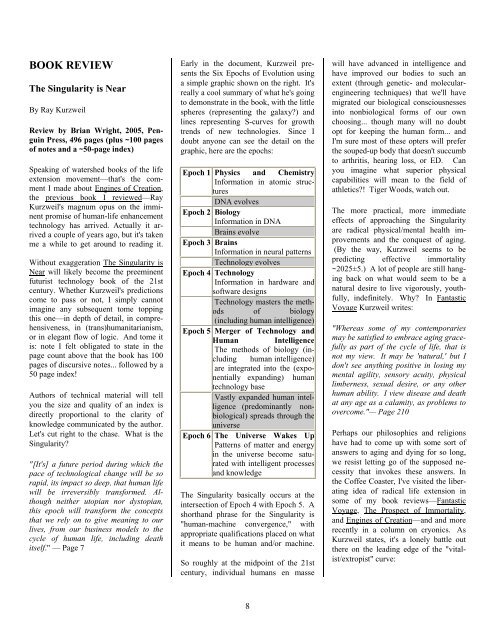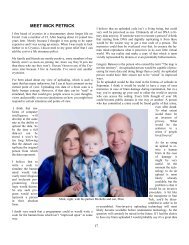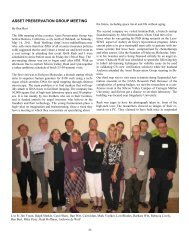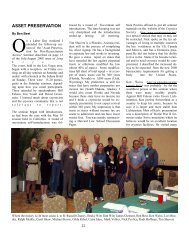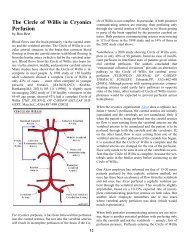Book Review, Comments and Letters - Cryonics Institute
Book Review, Comments and Letters - Cryonics Institute
Book Review, Comments and Letters - Cryonics Institute
You also want an ePaper? Increase the reach of your titles
YUMPU automatically turns print PDFs into web optimized ePapers that Google loves.
BOOK REVIEW<br />
The Singularity is Near<br />
By Ray Kurzweil<br />
<strong>Review</strong> by Brian Wright, 2005, Penguin<br />
Press, 496 pages (plus ~100 pages<br />
of notes <strong>and</strong> a ~50-page index)<br />
Speaking of watershed books of the life<br />
extension movement—that's the comment<br />
I made about Engines of Creation,<br />
the previous book I reviewed—Ray<br />
Kurzweil's magnum opus on the imminent<br />
promise of human-life enhancement<br />
technology has arrived. Actually it arrived<br />
a couple of years ago, but it's taken<br />
me a while to get around to reading it.<br />
Without exaggeration The Singularity is<br />
Near will likely become the preeminent<br />
futurist technology book of the 21st<br />
century. Whether Kurzweil's predictions<br />
come to pass or not, I simply cannot<br />
imagine any subsequent tome topping<br />
this one—in depth of detail, in comprehensiveness,<br />
in (trans)humanitarianism,<br />
or in elegant flow of logic. And tome it<br />
is: note I felt obligated to state in the<br />
page count above that the book has 100<br />
pages of discursive notes... followed by a<br />
50 page index!<br />
Authors of technical material will tell<br />
you the size <strong>and</strong> quality of an index is<br />
directly proportional to the clarity of<br />
knowledge communicated by the author.<br />
Let's cut right to the chase. What is the<br />
Singularity?<br />
"[It's] a future period during which the<br />
pace of technological change will be so<br />
rapid, its impact so deep, that human life<br />
will be irreversibly transformed. Although<br />
neither utopian nor dystopian,<br />
this epoch will transform the concepts<br />
that we rely on to give meaning to our<br />
lives, from our business models to the<br />
cycle of human life, including death<br />
itself." — Page 7<br />
Early in the document, Kurzweil presents<br />
the Six Epochs of Evolution using<br />
a simple graphic shown on the right. It's<br />
really a cool summary of what he's going<br />
to demonstrate in the book, with the little<br />
spheres (representing the galaxy?) <strong>and</strong><br />
lines representing S-curves for growth<br />
trends of new technologies. Since I<br />
doubt anyone can see the detail on the<br />
graphic, here are the epochs:<br />
Epoch 1 Physics <strong>and</strong> Chemistry<br />
Information in atomic structures<br />
DNA evolves<br />
Epoch 2 Biology<br />
Information in DNA<br />
Brains evolve<br />
Epoch 3 Brains<br />
Information in neural patterns<br />
Technology evolves<br />
Epoch 4 Technology<br />
Information in hardware <strong>and</strong><br />
software designs<br />
Technology masters the methods<br />
of biology<br />
(including human intelligence)<br />
Epoch 5 Merger of Technology <strong>and</strong><br />
Human Intelligence<br />
The methods of biology (including<br />
human intelligence)<br />
are integrated into the (exponentially<br />
exp<strong>and</strong>ing) human<br />
technology base<br />
Vastly exp<strong>and</strong>ed human intelligence<br />
(predominantly nonbiological)<br />
spreads through the<br />
universe<br />
Epoch 6 The Universe Wakes Up<br />
Patterns of matter <strong>and</strong> energy<br />
in the universe become saturated<br />
with intelligent processes<br />
<strong>and</strong> knowledge<br />
The Singularity basically occurs at the<br />
intersection of Epoch 4 with Epoch 5. A<br />
shorth<strong>and</strong> phrase for the Singularity is<br />
"human-machine convergence," with<br />
appropriate qualifications placed on what<br />
it means to be human <strong>and</strong>/or machine.<br />
So roughly at the midpoint of the 21st<br />
century, individual humans en masse<br />
8<br />
will have advanced in intelligence <strong>and</strong><br />
have improved our bodies to such an<br />
extent (through genetic- <strong>and</strong> molecularengineering<br />
techniques) that we'll have<br />
migrated our biological consciousnesses<br />
into nonbiological forms of our own<br />
choosing... though many will no doubt<br />
opt for keeping the human form... <strong>and</strong><br />
I'm sure most of these opters will prefer<br />
the souped-up body that doesn't succumb<br />
to arthritis, hearing loss, or ED. Can<br />
you imagine what superior physical<br />
capabilities will mean to the field of<br />
athletics?! Tiger Woods, watch out.<br />
The more practical, more immediate<br />
effects of approaching the Singularity<br />
are radical physical/mental health improvements<br />
<strong>and</strong> the conquest of aging.<br />
(By the way, Kurzweil seems to be<br />
predicting effective immortality<br />
~2025±5.) A lot of people are still hanging<br />
back on what would seem to be a<br />
natural desire to live vigorously, youthfully,<br />
indefinitely. Why? In Fantastic<br />
Voyage Kurzweil writes:<br />
"Whereas some of my contemporaries<br />
may be satisfied to embrace aging gracefully<br />
as part of the cycle of life, that is<br />
not my view. It may be 'natural,' but I<br />
don't see anything positive in losing my<br />
mental agility, sensory acuity, physical<br />
limberness, sexual desire, or any other<br />
human ability. I view disease <strong>and</strong> death<br />
at any age as a calamity, as problems to<br />
overcome."— Page 210<br />
Perhaps our philosophies <strong>and</strong> religions<br />
have had to come up with some sort of<br />
answers to aging <strong>and</strong> dying for so long,<br />
we resist letting go of the supposed necessity<br />
that invokes these answers. In<br />
the Coffee Coaster, I've visited the liberating<br />
idea of radical life extension in<br />
some of my book reviews—Fantastic<br />
Voyage, The Prospect of Immortality,<br />
<strong>and</strong> Engines of Creation—<strong>and</strong> <strong>and</strong> more<br />
recently in a column on cryonics. As<br />
Kurzweil states, it's a lonely battle out<br />
there on the leading edge of the "vitalist/extropist"<br />
curve:
"Being a Singularitarian has often been<br />
an alienating <strong>and</strong> lonely experience for<br />
me because most people I encounter do<br />
not share my outlook. Most "big thinkers"<br />
are totally unaware of this big<br />
thought. In a myriad of statements <strong>and</strong><br />
comments, people typically evidence the<br />
common wisdom that human life is short,<br />
that our physical <strong>and</strong> intellectual reach<br />
is limited, <strong>and</strong> that nothing fundamental<br />
will change in our lifetimes. I expect this<br />
narrow view to change as the implications<br />
of accelerating change become<br />
increasingly apparent, but having more<br />
people with whom to share my outlook is<br />
a major reason that I wrote this book."<br />
— Page 370<br />
Thanks, Ray. With Singularity you've<br />
not only made more friends, you've<br />
combined a tour de force <strong>and</strong> coupe de<br />
grâce for the inspiration of rationally<br />
idealistic people everywhere. I expect<br />
one day, just as we talk about the Christian<br />
era in terms of BC <strong>and</strong> AD, we'll<br />
have another basis for gauging the centuries:<br />
BK <strong>and</strong> AK. Kurzweil does a lot of<br />
heavy lifting, systematically demonstrating<br />
the realities of the new technology,<br />
even some current concerns about environment<br />
<strong>and</strong> energy. We have reason to<br />
be optimistic. In particular, clean energy<br />
costs will drop <strong>and</strong> availability will rise:<br />
"Today solar power costs an estimated<br />
$2.75 per watt. Several companies are<br />
developing nanoscale solar cells.... Industry<br />
sources indicate that once solar<br />
power falls below $1.00 per watt, it will<br />
be competitive for directly supplying<br />
electricity to the nation's power grid.<br />
Nanosolar [company] has a design<br />
based on titanium oxide nanoparticles<br />
that can be mass-produced on very thin<br />
flexible films. CEO Martin Roscheisen<br />
estimates that his technology has the<br />
potential to bring down solar-power<br />
costs to around 50 cents per watt by<br />
2006[1], lower than that of natural gas.<br />
Competitors Nanosys <strong>and</strong> Konarka have<br />
similar projections."— Page 250<br />
So in the lead up to the Singularity lie<br />
such important matters as cleanup of<br />
pollution <strong>and</strong> resolution of global warming<br />
caused by fossil-fuel carbon-dioxide<br />
emissions. Not an insignificant issue, as<br />
I've also discussed in several reviews.[2]<br />
"Of the three primary revolutions underlying<br />
the Singularity (genetics,<br />
nanotechnology, <strong>and</strong> robotics (GNR)),<br />
the most profound is R, which refers to<br />
the nonbiological intelligence that exceeds<br />
that of unenhanced humans. A<br />
more intelligent process will inherently<br />
outcompete one that is less intelligent,<br />
making intelligence the most powerful<br />
force in the universe." — Page 260<br />
Hard to believe intelligence will someday<br />
rule the world, at least from our<br />
current vantage point here in the murky<br />
shadows of George Bush, Sean Hannity,<br />
<strong>and</strong> Bill O'Reilly. But once we purge the<br />
world of pathocracy of all varieties <strong>and</strong><br />
achieve the vision of decentralized voluntary<br />
communities, success will become<br />
straightforward.<br />
To describe the panorama of fundamental<br />
observations made by Mr. Kurzweil<br />
would require a substantial book in itself.<br />
He begins by justifying the principles<br />
of technological evolution <strong>and</strong> the<br />
Law of Accelerating Returns, spends two<br />
chapters describing how to achieve the<br />
computational capacity of the human<br />
brain, outlines the impact on the human<br />
body or other enhanced intelligencecarrying<br />
framework, several sections on<br />
how to best contain or thwart the perils<br />
of malevolent strong AI (artificial intelligence),<br />
<strong>and</strong> finally some deep insightladen<br />
essays on consciousness <strong>and</strong> Singularity<br />
as Transcendence.<br />
"...Singularitarianism is not a system of<br />
beliefs or unified viewpoints. While it is<br />
fundamentally an underst<strong>and</strong>ing of basic<br />
technology trends, it is simultaneously<br />
an insight that causes one to rethink<br />
everything, from the nature of health <strong>and</strong><br />
wealth to the nature of death <strong>and</strong> self."<br />
— Page 371<br />
9<br />
UH-OH: CHRIS MANNING<br />
COMMENTS ON THE LAST<br />
ISSUE<br />
As we said once before, when Chris reads<br />
something, he must do it line by line. We<br />
thank him for bringing these things to our<br />
attention.<br />
CI President's Report (page 3)<br />
I hope rats <strong>and</strong> any other animals being<br />
used in experiments done on behalf of CI<br />
are being treated humanely. I would also<br />
hope that experiments on live animals are<br />
only being performed when there is no<br />
reasonable alternative<br />
I am a vegetarian <strong>and</strong> I am sympathetic to<br />
the aims of the animal liberation movement,<br />
but I am *not* convinced that animal<br />
experiments are always unjustified.<br />
A New Spirit of Preservation (page 5)<br />
I note the reference to 'baby boomers'. I<br />
was born in 1956. I remember that the<br />
term was in use in the mid to late '60s<br />
when I was a boy in Sydney, but at that<br />
time it referred only to people born in<br />
the first five (5) years after the War. So, I<br />
was *not* a ‘baby boomer’ then. Now, I<br />
gather, I *am* a 'baby boomer' as the term<br />
now refers to anyone born between 1946<br />
<strong>and</strong> 1960. (Or is it 1965?)<br />
Ending Aging (page 7)So the FDA does<br />
not regard ageing as a disease. I assume it<br />
regards progeria as a disease. I suggest<br />
that 'ordinary' ageing should be regarded<br />
as a disease as it differs from progeria only<br />
in degree <strong>and</strong> not in kind.<br />
Perhaps this argument could be put to the<br />
FDA? If it is true that more lives are lost<br />
than are saved by slow FDA approval of<br />
drugs then I would have thought they<br />
should be made aware of that argument as<br />
well.<br />
BTW this might be pedantry on my part,<br />
but it is probably better to use the word<br />
'youthful' rather than 'young' when referring<br />
to the rejuvnationtion of middle-aged<br />
mice.<br />
God Wants You Dead (page 10)<br />
The concern about people seeing these
CHRIS MANNING<br />
words on the cover of Long Life could<br />
probably have been allayed simply by making<br />
them part of a larger whole, less susceptible<br />
of misinterpretation, such as '<strong>Book</strong><br />
<strong>Review</strong>: God Wants You Dead.'<br />
Yes, in retrospect, this would have been<br />
wiser.<br />
Regarding the problem of personal identity,<br />
my own belief FWIW is that, in terms of<br />
one's sense of personal identity, revival<br />
from suspension would be no different from<br />
regaining consciousness after<br />
an operation, or even waking up in the<br />
morning.<br />
Report from Russia (page 12)<br />
Was Lenin expecting to be revived or is Dr<br />
Pichugin being facetious? BTW in my mind I<br />
have been pronouncing his name 'pit-<br />
CHEW-gin' (with 'gin' as in 'begin'). I trust<br />
this is correct. Chris-Leave out the “t”—<br />
piCHEW-gin.<br />
(At this point I wave back to 'Olya' who<br />
incidentally appears to be sporting a pair of<br />
Levis. I seem to remember reading somewhere<br />
that these are expensive <strong>and</strong> prized<br />
possessions in Russia.)<br />
We neglected to say that Olya was a TV<br />
personality, <strong>and</strong> was part of a crew videotaping<br />
a report for Russian TV.<br />
CIYG Digest (page 15)<br />
Longevity Insurance<br />
I would be getting as many predictive tests<br />
done as possible to ascertain my likelihood<br />
of reaching 85. No point in buying longevity<br />
insurance if I am going to discover next<br />
week that I have some degenerative disease.<br />
One thing the article didn't mention<br />
was, ‘Assuming you make it to 85, how<br />
much longer do you need to live to get your<br />
money back?' For the example given in the<br />
article, the answer appears to be<br />
(50,000/40,800) years or about 15 months.<br />
A Difficult Conversation What is a Tuff<br />
shed?<br />
“TUFF” is the name of a line of outdoor<br />
storage sheds.<br />
Bioethics <strong>and</strong> Life Extension (page 16)<br />
The university in Baltimore where Francis<br />
Fukuyama works is Johns Hopkins (not<br />
John Hopkins). That one is a common<br />
mistake which I already knew. However, I<br />
needed to do a Google search to verify that<br />
it's the Hastings Center, based in Briarcliff<br />
Manor, NY, which studies biomedical ethics.<br />
WHY I THINK CRYONICS HAS A REA-<br />
SONABLE CHANCE OF WORKING<br />
(page 17) The type of calculation to which<br />
Marta refers is called a Fermi calculation or<br />
a back-of-the-envelope calculation. The<br />
popularization of such calculations is one of<br />
the lesser known achievements of the<br />
physicist Enrico Fermi. About con men I will<br />
have a few words to say in a separate<br />
email. To part with your money or life is to<br />
'lose' it.<br />
THERAPEUTIC HYPOTHERMIA (page<br />
21) My sister-in-law is a GP (physician) in<br />
Sydney. I will ask her whether she has used<br />
therapeutic hypothermia to treat patients<br />
after cardiac arrest.<br />
Peter Needs Your Help (page 23)<br />
A few years ago I read a science fiction<br />
story called 'At the Eschaton' by Charles<br />
Sheffield. I love this story dearly. It was in<br />
an anthology I borrowed from one of my<br />
local libraries. I have tried several times to<br />
find the book again, without success. The<br />
computer catalogue indicated that it was in<br />
an anthology called 'Far Futures' but when I<br />
procured the volume in question from the<br />
10<br />
shelf I found that it did not contain that<br />
story. I think there must be two books<br />
with the same name.<br />
Immortalist Society (page 25)<br />
I note that a gift subscription of 5 copies of<br />
Long Life (@ $20 a copy) would cost $100<br />
but 6 copies (@ $15 a copy) would cost<br />
only $90.<br />
We’ve changed this. See page --<br />
<strong>Cryonics</strong> <strong>Institute</strong> (page 25)<br />
This article alludes to something called 'The<br />
Immoralist Society'.<br />
This one floored us! This typo started in the<br />
Nov-Dec 2001 issue, <strong>and</strong> appears to have<br />
gone on continuously since then! Good job<br />
Chris!<br />
The Final Word (page 26)<br />
It has to be 'the unexplainable phenomenon<br />
was (or 'phenomena were' if we are<br />
talking about more than one of them)<br />
indeed consistent with Newton’s Laws.'<br />
The address of the Immortalist Society<br />
(back cover)<br />
As stated on page 25, the Immortalist<br />
Society is at the same premises as CI.<br />
As already pointed out by Bob (I think), it's<br />
24355, not 24335 Sorrentino Court. (i.e. it's<br />
not next door or just down the street<br />
from CI.)<br />
Could someone please explain to me why<br />
such high street numbers are used in the<br />
US? It isn't that everything in the US has to<br />
be big, is it? (That's just Texas.) And I have<br />
seen the Google map of the area around<br />
the CI facility, <strong>and</strong> Sorrentino Court is only<br />
a little street. Here in Australia (<strong>and</strong> I think<br />
in most other places), the numbers in<br />
a street typically go 1, 3, 5, ... on one side<br />
<strong>and</strong> 2, 4, 6, ... on the other. Many years<br />
ago I visited <strong>and</strong> stayed with a gentleman<br />
at his house in San Francisco. Its street<br />
number was 1311, but by walking along the<br />
street I worked out that if it had been<br />
numbered as in Australia, his street number<br />
would have been 79.
I believe the main reason for large street<br />
numbers in the Detroit area is<br />
the custom of starting numbers near the<br />
Detroit River <strong>and</strong> increasing at greater<br />
distances, including the suburbs. The CI<br />
street number of 24355 Sorrentino<br />
Court, <strong>and</strong> my home address of 35871<br />
Larchwood (Larchwood is only one block<br />
long!) probably refers to the distance from<br />
the Detrolit River or/<strong>and</strong> the<br />
distance from some east-west marker such<br />
as Lake St. Clair. Monumentally unimportant--Bob<br />
(Ettinger)<br />
In the US, it is not unusual for street numbers<br />
to increment by units of 100 for each<br />
cross street, <strong>and</strong>/or to match the numeration<br />
of cross streets. i.e. 200-299 Union<br />
Street would be between 2nd <strong>and</strong> 3rd<br />
Avenue.-Ellie.<br />
BTW Marta mentioned in her article that by<br />
'WA' she means 'Western Australia'. Whilst<br />
on the subject of big things I will take the<br />
opportunity to mention that Western Australia<br />
is about three (3) times the size of<br />
Texas. It boasts the largest electorate<br />
constituency; congressional district in the<br />
world, that of Kalgoorlie, which covers most<br />
of the area of WA.<br />
A note on terminology In a recent message,<br />
'Wills <strong>and</strong> Funerals' I mentioned the 'solicitor'<br />
who did my will. I have just remembered<br />
that this word is not used in the US. I<br />
think you call them 'attorneys'. BTW today<br />
(Saturday 26 January) is Australia Day, our<br />
equivalent of July 4. It is the anniversary of<br />
the day in 1788 when Captain Arthur<br />
Phillip arrived with the first shipload of<br />
convicts from Engl<strong>and</strong>. Greetings to Marta<br />
<strong>and</strong> any other Australians who may happen<br />
to be reading this.<br />
***********************************<br />
I recently posted to the CI Yahoo group<br />
some comments about the Jan-Feb issue<br />
of Long Life. I suppose you will be printing<br />
all or some of these comments in the<br />
next issue, as you have done in the past.<br />
If it isn't already too late, I would prefer<br />
that you didn't print my comments about<br />
typos. I made one of my own! It's Francis<br />
Fukuyama, not Frances. If you do<br />
print my typo comments, I would be<br />
grateful if you could also print this correction<br />
(or print my comments with the<br />
spelling of that name corrected).--Chris<br />
Manning<br />
LETTERS<br />
Yesterday I received the first 2008 issue<br />
of long life, <strong>and</strong> was heartened by the<br />
good job John Bull <strong>and</strong> contributors are<br />
doing.<br />
One small problem noted--the back<br />
cover has the wrong address for CI. It is<br />
shown as 24335 Sorrentino Court, but<br />
should be 24355.<br />
Ben <strong>and</strong> York <strong>and</strong> Marta shed a lot of<br />
light, <strong>and</strong> David Center's piece was<br />
good, <strong>and</strong> Catherine Baldwin's contribution<br />
offered some information.<br />
Aubrey de Grey suggested Wired magazine<br />
as venue for a Science Court type<br />
essay contest, <strong>and</strong> I have queried the<br />
editor in chief.<br />
Dr. de Grey also asked for citations<br />
concerning Bjorksten's writings on cross<br />
linkage <strong>and</strong> soil enzymes. See "The<br />
Crosslinkage Theory of Aging," Journal<br />
of the American Geriatric Society, v. 23,<br />
April 1968. Also "Theories (of Aging)"<br />
in the book Aging Life Processes, ed.<br />
Seymour Bakerman, Charles C. Thomas<br />
publisher, 1969.--Bob (Ettinger)<br />
Hi John Bull,<br />
My compliments for keeping the long<br />
life magazine going every 2 months,<br />
reading it seldom bores me. Keep it up.<br />
I would like to request a change for the<br />
page '<strong>Cryonics</strong> Support Groups Worldwide'<br />
(inside back cover), for "NETH-<br />
ERLANDS". The chairman of the Dutch<br />
<strong>Cryonics</strong> Organization stepped down late<br />
2007, <strong>and</strong> George Overmeire took his<br />
place as the new chairman. I became the<br />
new secretary, <strong>and</strong> George requested me<br />
to have the now outdated information in<br />
Long Life changed. After 6 years, the<br />
organization currently has 6 paying<br />
members (~$500 per year each, including<br />
one student!) <strong>and</strong> we just purchased<br />
2 Ambu cardio pumps as our first<br />
st<strong>and</strong>by equipment. It's a Good Thing to<br />
see likeminded people team up <strong>and</strong> it's<br />
even better to have the listing of st<strong>and</strong>by<br />
11<br />
groups in Long Life growing <strong>and</strong> growing.<br />
Our CURRENT infoline reads like<br />
this:<br />
"NETHERLANDS: The Dutch <strong>Cryonics</strong><br />
Organization is growing<br />
http://www.cryonisme.nl Contact Secretary<br />
George Overmeire at +31 (0) 70-<br />
3503914, or mobile phone +31-<br />
(0)615092301. e-mail:<br />
george@georgeovermeire.nl"<br />
The FUTURE infoline should read like<br />
this "NETHERLANDS: The Dutch<br />
<strong>Cryonics</strong> Organization is the local<br />
st<strong>and</strong>by group <strong>and</strong> welcomes new enthusiasts<br />
(http://www.cryonisme.nl).<br />
Contact Secretary Jappie Hoekstra at<br />
+31-(0)6-53213893 or e-mail:<br />
jh@hoekstra-media.nl"<br />
I kept the text at the same length as the<br />
current text, so you won't run out of<br />
space already :-) Thank you!<br />
Jappie Hoekstra<br />
David Flude reports on a unique <strong>and</strong><br />
also chilling medical treatment—<br />
I have done a summary as follows:<br />
"UK's Top Jockey, Tony McCoy is using<br />
a Kriotherapy Freezer Chamber at the<br />
exclusive Champneys Health Resort in<br />
Hertfordshire, UK to cure his multiple<br />
fractured vertebra. Clad only in Boxer<br />
shorts, Gloves, Socks & a Mask, Tony is<br />
freezing himself to fitness at Minus -145<br />
Celsius. He st<strong>and</strong>s in the bone chilling<br />
Liquid Nitrogen Chamber for 3 minutes<br />
at a time, twice a day over a period of<br />
several weeks. "It's so cold it's hard to<br />
explain, but you can feel yourself hardening!"<br />
he said."" Summarized from an<br />
article in the Daily Mail of February<br />
24th. 2008.<br />
.Kind regards<br />
David & May Flude<br />
When one door closes another door<br />
opens; but we so often look so long<br />
<strong>and</strong> so regretfully upon the closed<br />
door, that we do not see the ones<br />
which open for us. – Alex<strong>and</strong>er Graham<br />
Bell


